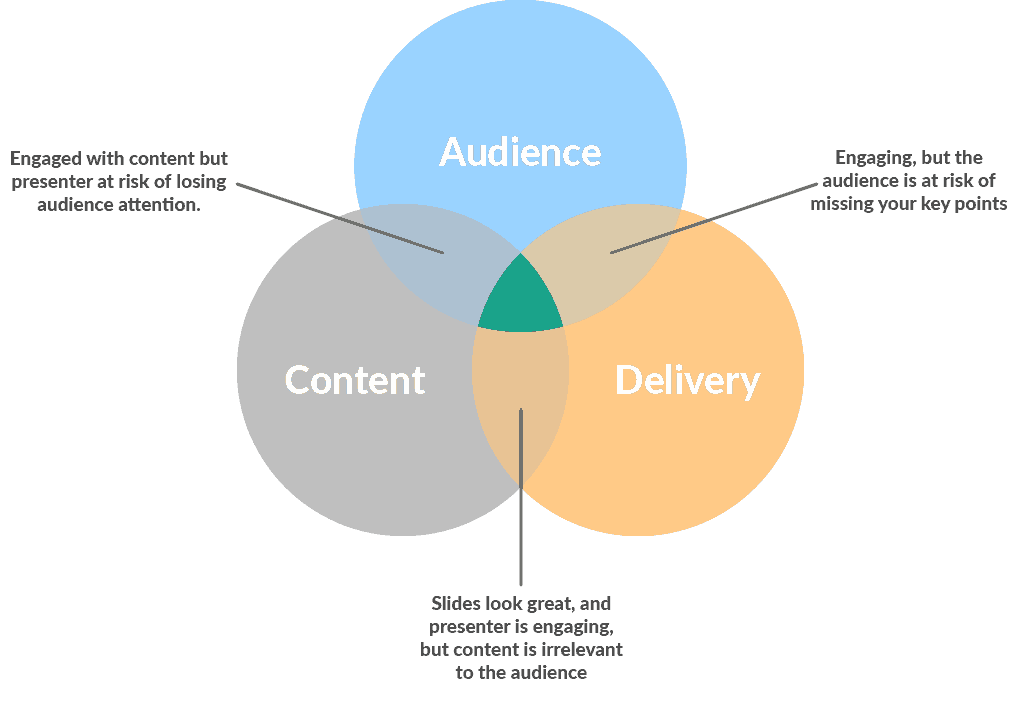Presentations. A great one can tell a compelling story, inspire an audience to change the way they think, or win a new client.
However, a bad presentation will leave people looking at their watches, scrambling for the nearest fire exit, or wondering if they can fit in a 20-minute sleep.
The difference between a great presentation and a bad one comes down to three things: audience, delivery, and content.
 |
Even if you’re not an experienced presenter, well-designed content can give you the confidence to deliver a presentation that captivates your audience, but it is vital that what you’re presenting to them provides value.
Understanding your content
We all know ‘death by PowerPoint’ is real, yet people still seem inexplicably drawn to it. Many presentations end up as on-screen prompt cards rather than the visual representation of your awesome idea or pitch.
But all is not lost. A little bit of creative guidance and an extra half an hour on your content, and you’ll be a presentation hero rather than a PowerPoint villain.
Everybody dreams that their presentation will be “tech company product launch” S tier content that’s headed for a standing ovation. But 99% of the time, you’ll need to create something that resonates with a small audience in a meeting room at the client’s office.
Regardless of audience size, the same principles apply for making content visually pleasing. However, it is necessary to consider your audience and subject matter when planning the tone and utility of any information you’re presenting. Making an emotional connection with your audience is the most important part of your presentation.
Look at your content & be honest with yourself
Being absolutely honest with yourself about the content is essential. If you only take away one point from this guide, it should be to place yourself in the shoes of the audience. Your content should pass what I like to call the ‘And? *shrug*’ test: does your content provide value to the audience, or will they just shrug and wonder why you’re telling them this?
Content order
Unless it’s on the client’s agenda, don’t start with 20 slides about your company history. This is effectively the same as going on a first date and only talking about yourself throughout the starter course. Even if the client wants you to tell them about your business, keep it short and weave it in as part of your narrative.
The best approach is to get stuck straight into the good stuff; showing the client you understand their needs, their challenges, and how your solution eases their pain points.
An example of a simple content order could be:
- A review of the client’s business as you understand it
- The client’s market
- Their challenges as you understand them
- How your solution addresses the challenges the client faces
- Case study
- A short overview of your company
Create a narrative
‘Telling a story’ may be a well-worn phrase in sales and marketing circles, but it still has value. We’re long past the simplistic ‘features and benefits’ approach to selling; few clients will purchase on a generic basis. Clients want relevance, they want bespoke solutions and social proof of your firm’s quality.
Using the basic content order you formulated earlier, create a story that takes the client from their current challenge, shows empathy for that struggle, and introduces your solution as the answer.
Work your content
Work on enough presentations with other teams and you’ll eventually hear the words “I need to get all of the information I’m going to talk about on to the slides“.
There will be times when creating a content-heavy presentation is unavoidable. However, content-heavy presentations can be made palatable by putting some thought into the content and design it for maximum impact.
It’s a fact that people can read faster than you can talk. This means that once you have finished talking through your first point, they’ve already read everything else on the slide, and in the process didn’t pay attention to a word you said.
The best place to start is to distill the key points from your base content to create succinct messages that support your narrative.
You should avoid large volumes of text on a slide; it doesn’t matter how you break it up, an audience straining to read a long paragraph or a dozen bullet points will wear thin very fast. You may hear people suggesting that up to 7 bullet points on your slide are fine, but this concept should be returned to 1997 where it belongs.
Use this rule: one point or topic per slide. If you’re really feeling daring, try reducing content down to a phrase, a single word or maybe just a representative image or graphic. Be brutal – delete all unnecessary content.
Lastly, if any information doesn’t matter or the audience “doesn’t need to read it anyway”, why is it in your presentation in the first place?
Remove the safety blanket
A bad habit guaranteed to tank your presentation is placing every word you want to say on the slide, then reading it from the slide verbatim. There are multiple reasons this is a bad idea:
- You have to turn away from your audience to read the text from the screen behind you (or squint at a monitor in front of you)
- If you’re reciting content verbatim from a slide, the audience will have finished reading the text long before you’ve finished reciting it. At that point, you’re surplus to requirements as a presenter.
- This isn’t an audiobook
Inexperienced presenters often fill slides with text as a ‘safety blanket’; they’re scared that they might forget something. If you can’t go without a ‘content safety blanket’:
- Use discreet, succinct paper notes
- Create electronic notes for use with split-screen ‘presenter mode’ in PowerPoint
- Practice more until you commit all content to memory
Supporting Information
If you need to expand on a topic, offer detailed supporting information or provide in-depth analysis, create handouts to give to the audience. How you manage handouts will be dependent on the situation:
- In a larger conference or keynote situation, offer any handouts at the end of the presentation
- In a small meeting situation, provide handouts at the point that they are needed. If you provide the entire handout at the start, many people will race ahead and read all the notes; they are then not listening to you.
That empty space, it’s not empty
Many amateur presenters are scared of leaving white or ‘empty space in presentation slides. There’s an overwhelming temptation to fill every part of a presentation slide – somehow that empty space feels… awkward. Well here’s a pro-tip: leave the empty space in there.
White space (also known as negative space) gives the content on your slide room to breathe. Too much content on a slide looks cluttered and can be distracting for the audience.
White space can help you emphasize a point, an image or a graphic that’s relevant to your talk. It makes things stand out.
There’s no such thing as too many slides
30 slides thick with dry, wordy content will grind an audience down. 30 engaging, well-designed presentation slides that you’ve properly rehearsed, can help create a dynamic, flowing audience journey.
You should always look to keep a presentation as succinct as possible, so always be looking for ways to trim out unnecessary content; often this will only be apparent once you start to rehearse a presentation.
Lots of slides does not always mean a longer presentation; a presentation long is long because of:
- Waffling.
- Reading text verbatim from the slide.
- Pausing on a slide to allow the audience to read your novel’s worth of text because you reduced the font size to 10 to fit it on.
A common problem will be that you’re asked by a third party to reduce the number of slides in your presentation. Be warned that arbitrarily reducing a slide count from 10 slides to 3 by squeezing all the same info into fewer slides isn’t accomplishing anything. Reducing content down in the way simply makes it harder for your audience to decipher your content.
Part two of our presentation guide will be available next week.



